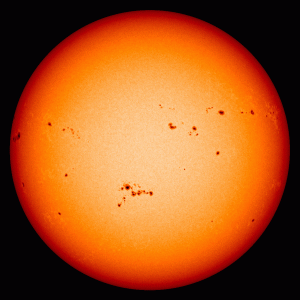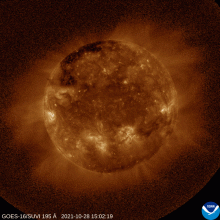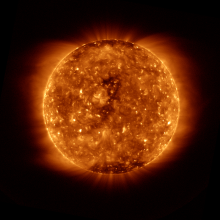Dark magnetic storms speckle the surface of the Sun in this false-color image from SOHO, a Sun-watching spacecraft. The storms are known as sunspots. They appear dark because they are cooler than the surrounding gas. On their own, however, they would glow dull reddish orange. The image was taken in 2000, when the Sun was much more active than it has been in recent years. [NASA/ESA/SOHO]
You are here
Dark Storms
Seen from above, storms here on Earth are bright white. On the Sun, though, the storms look dark.
Sunspots are produced by the Sun’s magnetic field. Because the Sun is a ball of gas, different latitudes spin at different rates. That causes the Sun’s lines of magnetic force to get twisted and tangled. They poke through the surface, where they “push” against the hot gas. That reduces the flow of gas from deep within the Sun, producing blotches that can be several thousand degrees cooler than the rest of the surface.
A cooler gas emits less light than a hotter one, so the sunspots look dark. But they’re not as dark as they appear. If you could pull one out and look at it on its own, it would glow reddish-orange. It’s dark only when compared to the brighter surface around it.
Sunspots appear in cycles that last about 11 years.
When a cycle begins, the Sun’s magnetic field is well organized. As the field lines begin to twist, though, sunspots begin to pop up, and always at high latitudes — not far from the poles. Over time, the number of spots goes up, and the spots move closer to the equator. At the cycle’s peak, there can be scores of sunspots. After that, the magnetic field begins to reorganize itself, so the number of spots goes down.
The current cycle has been one of the quietest ever seen. And it’s on the way down, with a period of minimum activity in a year or two — a time where we might go days with no sunspots at all.
Script by Damond Benningfield
Get Premium Audio
Listen to today's episode of StarDate on the web the same day it airs in high-quality streaming audio without any extra ads or announcements. Choose a $8 one-month pass, or listen every day for a year for just $30.







